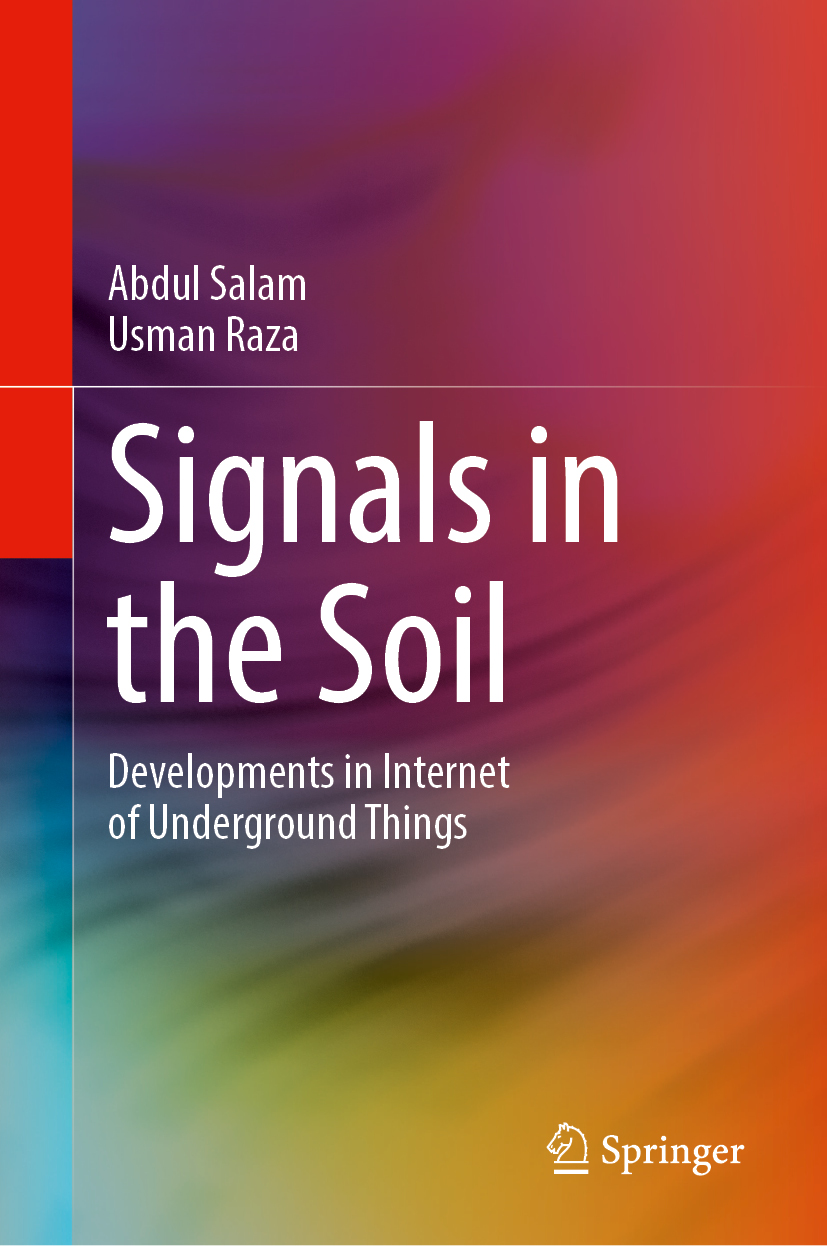- Publisher: Springer Nature
- Edition: 1st, 2020
- Hardcover ISBN: 978-3-030-50860-9
- eBook ISBN: 978-3-030-50861-6
- DOI: 10.1007/978-3-030-50861-6
This book provides an in-depth coverage of the most recent developments
in the field of wireless underground communications, from both theoretical
and practical perspectives. The authors identify technical challenges and
discuss recent results related to improvements in wireless underground
communications and soil sensing in Internet of Underground Things (IOUT).
The book covers both existing network technologies and those currently in
development in three major areas of SitS: wireless underground
communications, subsurface sensing, and antennas in the soil medium. The
authors explore novel applications of Internet of Underground Things in
digital agriculture and autonomous irrigation management domains. The book
is relevant to wireless researchers, academics, students, and decision
agriculture professionals. The contents of the book are arranged in a
comprehensive and easily accessible format.
- Focuses on fundamental issues of wireless underground communication and subsurface sensing
- Includes advanced treatment of IOUT custom applications of variable-rate technologies in the field of decision agriculture, and covers protocol design and wireless underground channel modeling
- Provides a detailed set of path loss, antenna, and wireless underground channel measurements in various novel Signals in the Soil (SitS) testbed settings
Preface
The farming sector is mainly responsible for the
world's food needs, however, land degradation, contamination, poor
agricultural techniques and practices, and urbanization are diminishing this
resource. Therefore, given the rapidly increasing world's population, soil
must be considered a natural resource as important as water and air. Soil
has billions of organisms which initiates chemical, biological and physical
processes required for fiber and food production, growth of the plant and
removal of contaminants from water, hence, an integral component of an
efficient farming ecosystem. Soil has many applications in human life as:
foundation of many structures which cannot be supported by rocks, widely
used material in construction sector, supply antibiotics to fight diseases,
and storage media for important gases (e.g., O_2, CO_2, CH_3).
Moreover, for proper functioning of underground infrastructure (pipelines,
tunnels, and basements), measures should be taken to prevent corrosion, soil
movement, environmental effects and groundwater seepage. U.S. government
spend billions of dollars to find and solve groundwater and soil
contamination due to hazardous material, e.g., deliberate and accidental
chemical spills, nuclear weapons production, and pipeline ruptures etc.
Therefore, it is imperative to understand the soil ecosystems with growing
population of the world so that it can efficiently be used in meeting
world's food demands. Moreover, this quote by Franklin D. Roosevelt: A nation that destroys its soils destroys
itself, still holds true
today.
Many credible national and international organizations
like National Science Foundation (NSF), the Directorates for Engineering
(ENG) and Geosciences (GEO), the Science and Technology Facilities Council
(STFC) of United Kingdom Research and Innovation (UKRI), the Division of
Integrative Organismal Systems in the Directorate for Biological Sciences
(BIO/IOS), the Division of Computer and Network Systems in the Directorate
Computer and Information Science and Engineering (CISE/CNS) in collaboration
with the US Department of Agriculture National Institute of Food and
Agriculture (USDA NIFA), the Engineering and Physical Sciences Research
Council (EPSRC), the Natural Environment Research Council (NERC), and the
Biotechnology and Biological Sciences Research Council (BBSRC), encourages
to do convergent and utilize underlying soil capabilities to its full extent
using sensor and modeling systems. To that end, collaborative effort from
interdisciplinary researchers, scientific community, and funding agencies is
required to develop advanced sensors, sensing systems, wireless
communication systems, soil models and cyber systems for complex problem
solving through education and outreach.
Lack of in-situ site-specific
measurements of biological, chemical, and physical properties hinders the
knowledge of dynamic soil changes. Currently, these properties are being
measured by either laboratory methods using soil samples from the sites or
soil models to predict soil states. However, these methods are based on
limited data and unreliable assumptions. Therefore, it is important to
develop sensing systems which provides advancement in detecting
spatio-temporal dynamic soil changes. The sensor systems must have the
capabilities to operate sensor, communicate wireless data being generated
from the sensor, integration with other available information, generate
analytic to observe spatial and temporal properties of managed and unmanaged
soils. It is not possible to detect the soil health through signals neither
the term "healthy soil" has proper definition. Therefore, it is important to
integrate fundamental science and engineering knowledge to for a capable
sensing systems. To that end, skills from different departments, e.g.,
biological, atmospheric, hydrological, biogeochemical, geological sciences
and engineering are combined for assessment, monitoring of functional and
sustainable soil. Furthermore, the senors system will need advanced ground
penetration, data transmission, dynamic modeling, data analytics, and
visualization tools. The purpose of the research is to develop the awareness
and understanding about the soil so that it can be managed using new and
innovative ways. It will also help in understanding the interaction between
soil and the life (e.g., plants and microorganisms etc.) supported by it.
Signals in the Soil adds new empirical and analytical results
to the body of knowledge which enables researchers and industry
professionals from the public and private sectors across the World to
accelerate research on underground wireless communication, sensing, and
networking technologies. It presents diverse and unique next-generation IoT
applications in urban and rural areas. It is an excellent book for graduate
students, academic researchers, and industry professionals, involved in
communication, sensing, agriculture, and bio-systems research.
This book provides an understanding of the most recent developments in
Signals in the Soil (SitS), from both the theoretical and practical
perspectives. It identifies and discusses technical challenges and recent
results related to improving wireless underground communications and sensing
in Internet of Underground Things (IOUT). It covers both existing network
technologies and those currently in development in three major areas of
SitS: wireless underground communications, subsurface sensing, and antennas
in the soil medium. It explores new applications of Internet of Underground
Things in digital agriculture and urban underground infrastructure
monitoring.
Signals in the Soil is an essential reference book
for advanced students on courses in wireless underground communications and
Internet of Things. It will also be of interest to researchers,
communication engineers, system and network planners, technical mangers and
other professionals in these fields. There is no book in the market on the
subject of wireless underground communications and Internet of Underground
Things. Currently, this audience gets information about this topic from
different sources (e.g., IEEE conferences, COMSOC tutorials, IEEE journals
and transactions articles, and web forums). The purpose of this book is to
transform information from these scattered sources into a comprehensive and
easily accessible knowledge body.
Signals in the Soil is
split into four parts: Physical Layer for Wireless Underground
Communications, Underground Antenna and Radio Interface Technologies; Novel
Soil Sensing Techniques; Internet of Underground Things Advancements;
Applications in Urban Underground Infrastructure Monitoring and Real-time
Soil Monitoring and Irrigation Automation. It starts by introducing emerging
technologies in wireless communications in soil medium before moving on to
cover propagation models, soil properties and beyond; beamforming, antenna
arrays and MIMO; capacity and path loss analysis; empirical and statistical
channel models in IOUT; underground antenna design; cross layer and
environment aware protocol design and energy harvesting and power transfer,
moving toward the applications in digital agriculture and urban underground
infrastructure monitoring; and more. This valuable resource:
-
Provides a comprehensive reference for all aspects of Signals in the Soil
-
Focuses on fundamental issues of wireless underground communication and subsurface sensing in an easy language that is understandable by a wide audience
-
Includes advanced treatment of IOUT custom applications of variable technologies in the field of digital agriculture, and covers protocol design and energy harvesting
-
Features on research developments and open research challenges in subsurface sensing
-
Provides a detailed set of path loss, antenna, and wireless underground channel measurements in novel indoor and field testbeds
The graduate students, precision equipment technician,
academic researchers, field applicators, industry professionals and mangers,
dealerships, and digital agriculture sales specialist are the intended
audience of Signals in the Soil. There are many such individuals in academia and digital
agriculture technology business, which is mostly targeted to the
applications of technology in big and small agricultural fields. Moreover,
the use of digital agriculture technology in diverse topographic and soil
texture fields is also expanding. To effectively utilize enormous data being
generated from the agricultural farms, this book has introduced technologies
which are useful for data collection, design of decision tools,
interpretation, and real-time decision making in the field.
About the Authors
Dr. Abdul Salam is an Assistant Professor with the Department of Computer and Information Technology, Purdue University. He holds a Ph.D. from University of Nebraska–Lincoln. He is the Director of the Environmental Networking Technology Laboratory at Purdue University. He has also taught at the Bahauddin Zakariya University, Multan and Islamia University, Bahawalpur. He served in Pakistan Army for nine years in a number of command, staff, and field roles. He held the principal position at the Army Public School and College, Thal Cantonment. He has won several awards including the ICCCN 2016 Best Student Paper Award, the Robert B. Daugherty Water for Food Institute Fellowship, the Gold Medal MS (CS) on securing first position in order of merit, and the 2016–2017 Outstanding Graduate Student Research Award from the University of Nebraska–Lincoln. He is the author of two books, Internet of Things for Sustainable Community Development, and Signals in the Soil. He has published over 50 research articles in major journals and international conferences. His recent research focuses on underground soil sensing, wireless communications, Internet of underground things in digital agriculture, sensor-guided irrigation systems, and vehicular communications. He has served as an Associate Editor for the IEEE GRSS Remote Sensing Code Library from 2016 to 2018. He serves as the Associate Editor of the Advanced Electromagnetics Journal and Array (Elsevier). Dr. Salam received his B.Sc. and M.S. degrees in computer science from Bahauddin Zakariya University, Multan, Pakistan, in 2001 and 2004, respectively, the M.S. degree in computer engineering from UET, Taxila, Pakistan, in 2012, and the Ph.D. degree in computer engineering from the Cyber-Physical Networking Laboratory, Department of Computer Science and Engineering, University of Nebraska–Lincoln, Lincoln, NE, USA.
Usman Raza is a Ph.D. student in computer and information technology at the Purdue University and a research assistant at Environmental Networking Technology (ENT) Laboratory under the supervision of Dr. Abdul Salam. His research involves Internet of Underground Things, including the channel model, connectivity and network protocols.



